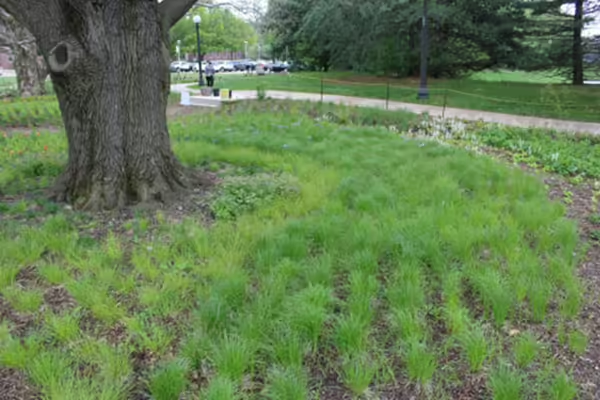
URBANA, Ill. – Trees are natural caretakers – their limbs provide shade and shelter, their seeds and leaves provide food, their roots filter water. Insect scientists have another skill to add to the list – a haven for caterpillars. Entomologists are asking gardeners, homeowners, and landscapers to stop mowing and instead add permanent plantings under tree canopies to help moths and butterfly caterpillars survive.
Biologist, pollinator conservationist, and award-winning author Heather Holm describes these plantings as soft landings for insects. Once the caterpillar of a moth or butterfly eats its fill of tree leaves, most of the time it drops to the ground to pupate. It may burrow into leaf litter or the ground.
“However, most people leave grass under trees, which has to be mowed,” says Kelly Allsup, former University of Illinois Extension Horticulture Educator. “This creates an ecological trap preventing butterflies and moths from reaching adulthood.”
A soft landing is critical under certain trees such as oak, willow, cherry, pines, and poplars. These keystone species trees feed a lot of species of butterfly and moth caterpillars. According to famed entomologist and author Doug Tallamy, oak trees support 534 species of lepidoptera, the insect order containing butterflies and moths, and black cherry supports 456 species. One of Illinois’ most well-known moths, the Polyphemus moth, feeds on oak and black cherry trees.
Erin Garrett, Extension Natural Resources, Environment, and Energy educator, asks homeowners to picture the habitat around one of their trees.
“Is the lawn under that tree a safe space to be? No, it isn’t,” Garrett says. “With leaves raked up or mowed, and lawn grass mowed weekly, those caterpillars do not have a safe space to develop.”
These soft landings do more than prevent lawnmowers from running over pupating butterflies and moths, they also provide habitat for other beneficial insects such as bumblebees, fireflies, lacewings, and beetles.
To create a soft landing, first, figure out if your tree’s roots are sensitive to disturbance. We would never want to harm roots on a tree. Severing even one major root can cause the loss of 15% to 25% of the root system according to the International Society of Arboriculture. Those with sensitive trees should apply properly mulched rings.
If a soft landing is appropriate, smother grass with wet newspaper or mulch. Add compost 2 inches deep compost starting 18 inches from the trunk and ending at the dripline, or the overhead canopy, of the tree.
Use small plugs of groundcovers or seed mixed with small spring-flowering bulbs such as grape hyacinth, crocus, winter aconite, snow drops, or Siberian squill.
“Although most bulbs thrive in full sun, it is a myth that you cannot grow spring-flowering bulbs in shady areas because bulbs have bloomed before trees fully leaf out,” Allsup says.
These plants, which are available in flats as small plugs, are appropriate as a soft landing ground cover in dry shade.
Lamium has silver variegated leaves with showy purple, pink, or white flowers that bloom from May to July. It grows 6 to 9 inches tall and has a 2- to 3-foot spread. When planting, it is best to space plugs 18- to 24 inches apart. This plant is resistant to deer munching.
Pachysandra is an evergreen of whorled glossy leaves that blooms white in April. This plant grows 6 to 12 inches high and spreads 12 inches. Leave plugs 12 inches apart. It will need to be thinned once it is well established to prevent disease. It is resistant to rabbits and deer.
Epimedium has compound heart-shaped leaves on wiry stems that turn red in the fall. It boasts attractive flowers of red or yellow in May. It grows 12- to 14 inches tall and spreads about 18 inches. It can be slow growing but is resistant to rabbits and deer.
Blue Sedge spreads quickly and combats weeds. The bluish-greenish foliage forms a nice mound and blooms from mid-June to mid-July. This ground cover further contributes to biodiversity by hosting skipper butterfly caterpillars and providing seed for birds.
These plants are appropriate for wet shaded areas.
Wild ginger is a native ground cover with a kidney-shaped leaf that blooms in April at the base of the plant. When looking, you will find a purple cup-shaped flower that is usually covered by foliage. It grows 6- to 12 inches tall and spreads 12 to 18 inches. It is resistant to deer.
Sweet Woodruff has a delicate leaf but is a mat-forming ground cover that blooms white in late spring. It grows 8 to 12 inches tall and spreads 12 to 18 inches. It has fragrant flowers and foliage that smells like fresh-cut hay when crushed. It can be planted under black walnut trees.
SOURCE: Kelly Allsup, former Horticulture Educator, Illinois Extension
PHOTO: Planting grasses beneath tree canopies that do not need to be mowed, such as this fescue at the Red Oak Rain Garden in Urbana, ensures that the caterpillars of moths and butterflies survive to adulthood. Photo by Layne Knoche.
Illinois Extension leads public outreach for University of Illinois by translating research into action plans that allow Illinois families, businesses, and community leaders to solve problems, make informed decisions, and adapt to changes and opportunities. Illinois Extension is part of the University of Illinois Urbana-Champaign College of Agricultural, Consumer and Environmental Sciences.